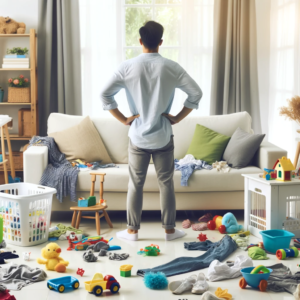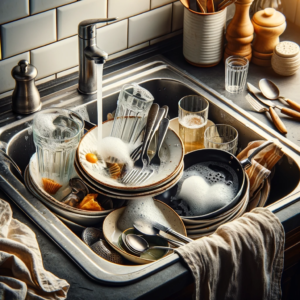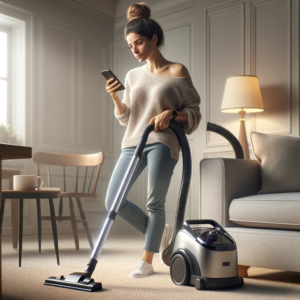Table of Contents
In our bustling lives, it’s surprisingly easy to fall into bad cleaning habits without even realizing their impact on our daily stress and living environment. Often, these cleaning habits creep up on us unnoticed, making our homes less organized and more chaotic than they need to be. But fear not, whether you’re looking to break free from these patterns for a cleaner, more serene living space or considering the convenience of hiring cleaning services in Philadelphia, PA for those busy days, this article is your guide. Let’s embark on a journey to transform our cleaning routines, making our homes not just tidy, but also peaceful havens from the hustle and bustle of life.
1. Neglecting Minor Messes

Overlooking the small messes in your home can lead to a cumulative effect, transforming your space from orderly to overwhelming. Instead of overlooking minor disarray, try tackling it immediately. This could mean quickly wiping off kitchen surfaces after use, ensuring the bathroom remains spotless post-use, or promptly organizing any paperwork. This proactive approach not only maintains a consistently tidy environment but also cultivates a habit of mindfulness and efficiency in your daily life. By addressing small tasks as they arise, you’ll find your space not only looks but feels more serene and manageable.
2. Leaving Unwashed Dishes in the Sink

Leaving dishes to soak overnight might seem like a time-saver, but it’s a bad cleaning habit that can lead to more work and stress. Not only does it attract pests like cockroaches and ants, but it also contributes to a cluttered, unhygienic kitchen. Instead, embrace a ‘Clean-as-You-Dine’ approach. Integrate cleaning into your cooking process by loading utensils and dishes into the dishwasher as they’re used, and wiping spills immediately. Post-meal, quickly stow away leftovers, run the dishwasher, and give your counters a swift wipe. This proactive habit transforms a tedious chore into a seamless part of your daily routine, ensuring a consistently fresh and inviting kitchen.
3. Food Forgotten Inside the Fridge

Neglecting to regularly clean out old food from the fridge can lead to more than just an unappetizing sight and unpleasant odors. Old, forgotten food can become a breeding ground for mold and bacteria, posing health risks. Keeping your fridge organized not only helps in identifying and discarding expired items promptly but also maintains a cleaner, healthier environment for your fresh food. Regular fridge check-ups can save you from potential health hazards and keep your food fresher, longer.
4. Decluttering As You Clean

Attempting to declutter while cleaning can actually hinder the effectiveness of both tasks. When you mix decluttering with cleaning, you’re likely to become overwhelmed, as each task requires a different focus and approach. Clutter can obscure dirt and make cleaning more cumbersome, leading to a half-hearted effort that neither declutters nor cleans effectively. Instead, set aside a dedicated time for decluttering. This focused effort not only prepares your space for a more thorough clean but also helps maintain a more organized, efficient living environment. Regular decluttering sessions, even as short as 10 minutes, can significantly reduce cleaning time and effort, leading to a more streamlined and enjoyable cleaning experience.
5. Combining Cleaning with Disinfecting

Rethink your approach to cleaning and disinfecting for a truly hygienic home. Cleaning and disinfecting are distinct tasks: cleaning targets dirt and grime, while disinfecting focuses on eliminating germs. When you use a disinfectant on a dirty surface, its effectiveness is compromised by the existing organic matter. The solution? First, clean surfaces with soap and water, ideally using a microfiber cloth for efficiency. Once clean, apply your chosen disinfectant, allowing it to work on a clear surface. Finish by wiping down with a fresh cloth. This two-step process ensures a deeper, more effective clean, keeping your home safer and more sanitary.
6. Overestimating The Task
Overestimating the time needed for housework can lead to procrastination, causing a build-up of mess and stress in your home. The key is to shift your mindset: rather than aiming for perfection, focus on what’s achievable in a short time. For example, set a timer for quick, focused cleaning bursts – five minutes for bathrooms, ten for kitchens, and around ten to fifteen for living rooms and bedrooms. This approach makes housework less daunting and more manageable, transforming an overwhelming task into a series of quick, satisfying wins that keep your home comfortably clean.
7. Cleaning with Unclean Tools

Revitalize your cleaning routine by focusing on the tools themselves. Using dirty cleaning tools can be counterproductive, spreading bacteria and dirt rather than removing them. A mop with old residue, for instance, can leave streaks on your floor, and a clogged vacuum cleaner becomes less effective. To ensure optimal cleaning, regularly wash rags and mop heads, clear out debris from your vacuum cleaner, and maintain your cleaning tools. This habit not only enhances their effectiveness but also extends their lifespan, ensuring a cleaner, healthier home environment.
8. Cleaning Based On Specific Tasks
Switching from task-based to room-based cleaning can revolutionize the way your home feels. With task-based cleaning, you might find yourself constantly tackling different chores each day without ever feeling like your house is completely clean. For instance, you might dedicate Mondays to dusting, Tuesdays to mopping, and so on. This method can be inefficient and disorganized. In contrast, room-based cleaning focuses on thoroughly cleaning one room at a time, from top to bottom. This method ensures every corner of a room is addressed before moving on, leading to a more organized, efficient cleaning process and a home that feels consistently clean and well-maintained.
9. Overusing Cleaning Products

Overusing cleaning products is a common issue, often stemming from a desire to tackle heavy dirt or simply not following product instructions. Using excessive amounts can lead to residue build-up, making surfaces sticky and attracting more dirt quickly. Instead, using just the right amount as recommended, followed by a thorough rinse or wipe, ensures cleanliness without creating a cycle of re-soiling. This not only saves time and effort in the long run but also conserves cleaning supplies and is more environmentally friendly. Remember, more product doesn’t always mean more clean!
10. Using Harsh chemicals

Opting for harsh chemicals in a rush to clean big messes can do more harm than good. These strong products, while effective in certain aspects, can pose health risks to your family and pets, potentially causing respiratory issues like asthma or chemical sensitivity. They can also be corrosive, shortening the lifespan of your household surfaces. Instead, consider using milder, more natural cleaning agents. For example, a mix of baking soda and soap makes an excellent kitchen cleaner, while diluted vinegar is great for windows. These gentler alternatives protect both your health and your home, offering effective cleaning without the harmful side effects.
11. Ignoring Product Directions

Ignoring the instructions on cleaning products can lead to inefficient cleaning and sometimes even damage to surfaces or health risks. Manufacturers provide specific guidelines because each product has unique chemical formulations and intended uses. Overlooking these instructions can result in using too much or too little product, not allowing enough time for it to work effectively, or misusing it on inappropriate surfaces. This not only diminishes the effectiveness of the cleaning but can also lead to unnecessary waste and potential hazards, underlining the importance of always reading and following product directions for optimal results.
12. Ignoring Top-Down Approach

Adopting a top-down approach in cleaning is crucial for efficiency and effectiveness. Starting with high areas like ceiling fans and cobwebs ensures that any dislodged dust falls to lower surfaces that haven’t yet been cleaned. By cleaning floors and lower surfaces last, you avoid the frustration of having to re-clean them due to falling debris from above. This method not only saves time but also ensures a thorough, more satisfying clean, leaving your home spotless from top to bottom. Remember, the right cleaning sequence can make all the difference!
13. Cleaning less frequently
Cleaning less frequently might seem like a time-saver, but it actually leads to more labor-intensive cleaning sessions. Regular maintenance, like sweeping every few days or wiping down surfaces weekly, prevents the buildup of dirt and dust. This approach makes deep cleaning sessions, like tackling ceiling fans, much less daunting and time-consuming. By incorporating smaller cleaning tasks into your regular routine, you can maintain a consistently clean environment and make those extensive cleaning efforts far more manageable and less overwhelming.
14. Leaving Dusting as the Final Task

Leaving dusting until the end of your cleaning routine is a common mistake that can double your workload. Dust particles, when disturbed, tend to scatter and settle on surfaces below. If you dust after cleaning floors or other surfaces, you’ll likely have to clean them again. It’s more effective to start your cleaning with dusting, removing particles from higher surfaces first and working your way down. This approach ensures a cleaner, more efficient process, keeping your home dust-free and fresh without the need for repetitive cleaning.
15. Getting Interrupted Once You Start a Task

Maintaining focus during cleaning is crucial for productivity. Distractions like emails, messages, or social media can significantly interrupt your cleaning flow, leading to unfinished tasks and prolonged cleaning time. To boost efficiency, commit to completing a task before taking a break. For example, if you start ironing, resist the urge to check your phone until you’re done. A helpful strategy is to put your phone aside and set a 10-20 minute timer for uninterrupted cleaning. This focused approach helps you maintain momentum and accomplish more in less time.
Seeking Help
If you do not have time and want some help with a full cleaning of your home, hire Cleanmate, professional cleaning service in Philadelphia as we will do all the hard work for you!
Request a Free Online Estimate or Call (267) 433 – 3399 Today!


